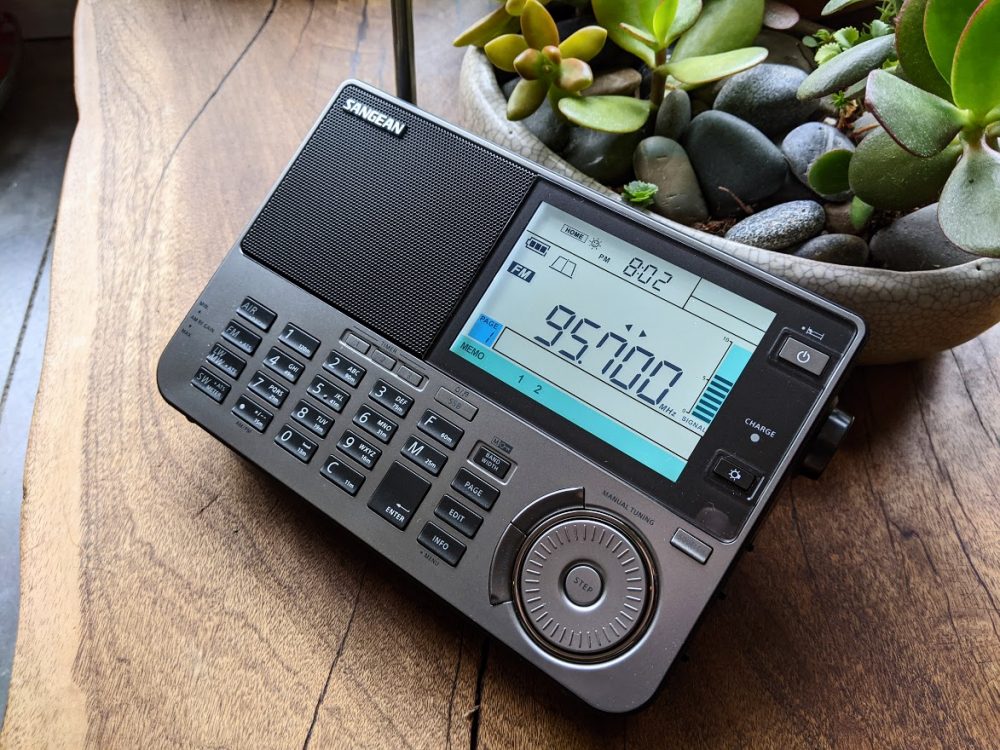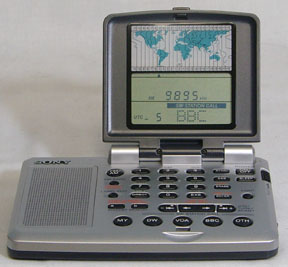 Many thanks to SWLing Post contributor, Pete Madtone who notes that a new Radio Lavalamp episode will air on Sunday, April 18, 2021 at 23:00 UTC via WRMI.
Many thanks to SWLing Post contributor, Pete Madtone who notes that a new Radio Lavalamp episode will air on Sunday, April 18, 2021 at 23:00 UTC via WRMI.
Thank you for the tip, Pete!

 Many thanks to SWLing Post contributor, Pete Madtone who notes that a new Radio Lavalamp episode will air on Sunday, April 18, 2021 at 23:00 UTC via WRMI.
Many thanks to SWLing Post contributor, Pete Madtone who notes that a new Radio Lavalamp episode will air on Sunday, April 18, 2021 at 23:00 UTC via WRMI.
Thank you for the tip, Pete!
 (Source: Rest Of World via Tom Daly)
(Source: Rest Of World via Tom Daly)
Young Burmese activists are broadcasting anti-coup messages on pirate radio
“This is revolution radio.”
In a safehouse in Yangon last Thursday morning, a small group of 20-somethings gathered to assemble a portable radio transmitter. For several hours, they broadcast translations of international news into Burmese—tributes to protesters killed by the armed forces, revolutionary songs and poems, and interviews with the leaders of Myanmar’s civil disobedience movement that has sprung up to oppose the military junta that seized power in February.
Then, they dismantled the equipment, each person taking a different piece by a different route to another safe location where they store it. Security is tight. They never broadcast from the same place twice, and the group use aliases, even among themselves. This is Federal FM Radio, live on 90.2 MHz.
Its name betrays its politics. Support for a federal Myanmar, one which rejects the state’s majoritarian Bamar identity and strives for true ethnic unity, has surged in the months since the coup. It is a message that does not sit well with the military government, which has responded with violent repression and internet blackouts. But young dissidents like these refuse to be silenced and have turned to old technologies to spread the word.
“This radio was born out of Myanmar’s Spring Revolution,” said one of its founders, who goes by “Mulan.” “This is revolution radio.”
The junta has imposed nightly internet blackouts to disrupt the protest movement, preventing people from organizing and communicating with the outside world. Social media platforms have been blocked, although many people continued to access them through virtual private networks.
However, on April 2, the mobile internet in Myanmar was completely switched off. Fixed-line connections are rare, and the move left millions of people unable to access news or to communicate with one another. In the vacuum, State media has broadcast propaganda that underplays the scale of the crisis, portrays protesters as “terrorists” and foreign agents, and blames the civil disobedience movement for recent violence on the streets.
“Our people need to get information, real information, because the military spread out fake news on their own media,” Mulan said. She and her colleagues were able to source radio equipment from a friend of the movement — they won’t say precisely who, for obvious reasons. The team is entirely made up of young, digital natives, and most of them were working for civil society organizations before the coup. None of them knew how to operate the gear, but they found technicians willing to train them. “So now, we are learning, like, a radio crash course,” Mulan said.[…]
Because I keep my ear to the waves, as well as receive many tips from others who do the same, I find myself privy to radio-related stories that might interest SWLing Post readers. To that end: Welcome to the SWLing Post’s Radio Waves, a collection of links to interesting stories making waves in the world of radio. Enjoy!
Many thanks to SWLing Post contributors Ulis (K3LU), Chris Walter, and Ron James for the following tips:
SpaceX doesn’t operate like a traditional aerospace company. For one, the CEO is usually hamming it up on Twitter during launches and providing details that would usually go in a press release. SpaceX also live streams almost all of its launches, even the prototypes that have an unfortunate tendency to blow up lately. It wasn’t even encrypting the Falcon 9 telemetry feed… until now. Unfortunately, some digging by amateur radio tinkerers seems to have convinced SpaceX to step up its security.
It all started a few weeks ago when several Redditors managed to lock onto the 2232.5 MHz telemetry downlink from a Falcon 9 upper stage. Right away, they were able to pull out a few interesting plaintext snippets from the unencrypted feed. With a little more work, the radio enthusiasts were able to capture some amazing images from the spacecraft’s cameras.
After that discovery was public, other SpaceX fans tried to grab some data from the Starship during its prototype tests. However, SpaceX had chosen to encrypt that data. Even with the right wireless equipment, the decoded signal was just noise. Now, it appears the same thing is happening with the Falcon 9. When attempting to pull data from the most recent Falcon 9 launch, the original signal snoopers discovered it had also been encrypted. A series of tweets from SpaceX engineers suggest the decoding of the telemetry signal was the reason for the change.[…]
BOSTON — A postcard written by the Titanic’s senior radio operator just weeks before the ocean liner sank in the North Atlantic in 1912 has been put up for auction.
The card, with a glossy image of the ill-fated ship on the front, was written by Jack Phillips to his sister, Elsie Phillips, in March 1912 while awaiting the ship’s first sea trials, according to RR Auction in Boston.
“Very busy working late. Hope to leave on Monday & arrive Soton Wednesday afternoon. Hope you quite OK. Heard from Ethel yesterday,” he wrote. It’s signed “Love Jack.”
It is postmarked Belfast, where the Titanic was built, and has a canceled halfpenny stamp.
“Soton” is a contraction of Southampton, the English port city from where the Titanic departed on its maiden voyage. It sank in the early morning hours of April 15.
Phillips, who turned 25 on board, stayed at his post after the Titanic struck an iceberg to send calls for assistance to other ships in the area until water was lapping around his feet, according to RR Auction.
He made it off the ship after being told by the captain that he had done his duty, according to his biography in the British National Archives, but died of exposure in the frigid North Atlantic, according to RR Auction.
The postcard is being sold by the estate of Vera and John Gillespie, longtime members of the Massachusetts-based Titanic Historical Society, said Bobby Livingston, executive vice president at RR Auction.[…]
What is sound art? And what do we know about its origin story? We explore this question and more with our guest this week, artist and educator Judy Dunaway. An adjunct professor in the History of Art Department at Massachusetts College of Art and Design, Dunaway’s recent article, “The Forgotten 1979 MoMA Sound Art Exhibition,” is a fascinating look at the history of sound art and highlights important contributions by female artists. In our wide-ranging discussion, we also hear about Dunaway’s own artistic practice, from her work with latex balloons to transmission art to a “phone improv” show over BlogTalkRadio a decade ago.
Click here to check out this piece at Radio Survivor.
A MATTER OF RECORD: Mighty useful gadgets are WNYC’s four new recording machines. They were used in a variety of interesting ways during the past year, so we decided that the how and the why of recording would be an appropriate subject for this, the third of our Behind the Microphone series dealing with the technical side of things at the Municipal Station.
One of the most valuable uses of the recording units is that they have partially enabled us to overcome the limitations of time — have made it possible to make available to our listeners important evening programs which we could not broadcast directly because of our fluctuating time allotment.
For instance, we could not pick up the ASCAP Music Festival Concerts from Carnegie Hall last Fall because WNYC was not on the air after 8:30 P. M.[1] What to do? The recorders to the rescue! The concerts were “broadcast” over our regular Carnegie Hall lines to the Municipal Building where they were transcribed on our two standard studio-type recording machines. Each transcription[2] was put on the air on the afternoon following the original perfor
Similarly, our two mobile recording units made possible an afternoon broadcast of the official opening of La Guardia Field which took place at midnight. Recording equipment is also used frequently to transcribe major programs “off the air” so that they may reach a larger audience through rebroadcast. There was the time, for example, when the Mayor’s office was the scene of a final report on the new Police and Fireman’s pension plan. Official reports on the balloting were recorded and rebroadcast at a time when the majority of the policemen and firemen affected could listen in.
We used to think recording an easy job: Just put the recording needle on the disk, turn a few buttons, and let ‘er go. After watching one of our expert recording engineers at work, we realized that it’s a delicate task, requiring special training and long practice.
Click here to read the full piece at WNYC.
Please consider supporting us via Patreon or our Coffee Fund!
Your support makes articles like this one possible. Thank you!


From the Isle of Music, April 18-24:
This week, in honor of Jazz Appreciation Month, we repeat a 2020 episode with special guest Harold López-Nussa.
The broadcasts take place:
1. For Eastern Europe but audible well beyond the target area in most of the Eastern Hemisphere (including parts of East Asia and Oceania) with 100Kw, Sunday 1500-1600 UTC on SpaceLine, 9400 KHz, from Sofia, Bulgaria (1800-1900 MSK)
2. For the Americas and parts of Europe, Tuesday 0000-0100 UTC on WBCQ, 7490 kHz from Monticello, ME, USA (Monday 8-9 PM EDT in the US).
3 & 4. For Europe and sometimes beyond, Tuesday 1900-2000 UTC and Saturday 1200-1300 (NEW UTC) on Channel 292, 6070 kHz from Rohrbach, Germany.
Our Facebook page is https://www.facebook.com/fromtheisleofmusic/
Our V-Kontakte page is https://vk.com/fromtheisleofmusic
Our Patreon page is https://www.patreon.com/tilford
Uncle Bill’s Melting Pot, April 18-24:
In episode 213, thanks to some suggestions about musicians from our listener friend Jaouad Saber in Morocco, we present some excellent music from that country.
The transmissions take place:
1.Sunday 2200-2300 UTC (6:00PM -7:00 PM EDT) on WBCQ The Planet 7490 kHz from the US to the Americas and parts of Europe
2. Tuesday 2000-2100 UTC on Channel 292, 6070 kHz from Rohrbach, Germany for Europe.
3. Saturday 0800-0900 UTC on Channel 292, 9670 kHz from Rohrbach, Germany for Europe with a directional booster aimed eastward,
AND a special broadcast Saturday at 1900-2000 UTC on Channel 292, 3955 kHz.
Our Facebook page is https://www.facebook.com/UncleBillsMeltingPot/
Our V-Kontakte page is https://vk.com/fromtheisleofmusic
Our Patreon page is https://www.patreon.com/tilford
 Many thanks to SWLing Post contributor, Dan Robinson, who notes that Dave (N9EWO) has posted his review of the Sangean ATS-909X2. Click here to view.
Many thanks to SWLing Post contributor, Dan Robinson, who notes that Dave (N9EWO) has posted his review of the Sangean ATS-909X2. Click here to view.
I must admit: as I put the Sangean ATS-909X2 through the paces, I’m impressed with this fine machine. While no radio is perfect, the ‘909X2 has enthusiast-grade characteristics.
The ATS-909X2 truly smacks of a shortwave portable from the 1990s–the halcyon days of digital portables, in my opinion. I personally love the ergonomics, display, audio, tactile front panel, numerous connections, and the quality chassis. It’s a pleasure to operate.
 Many thanks to SWLing Post contributor, William, who asks:
Many thanks to SWLing Post contributor, William, who asks:
Hello,
Firstly thank you for the blog – I have been reading occasionally for several years – it’s really interesting.
I live in the UK. I own (was given as a gift many years ago) a Sony ICF-SW07 and have been playing with it for the first time in the while.
I’m wondering if you remember it or ever used it, and if you can give me a rough idea if a new radio, such as the latest Tecsun, have considerably better sensitivity – for SW and MW – or not?
Many thanks.
William
Thank you for your question, William!
To my knowledge, I’ve only used a Sony ICF-SW07 once and it was from a hotel room at a radio convention, so not ideal for really gauging anything other than economics and superficial qualities. I do know that my friend held it in high regard. My inclination would be to say that the ICF-SW07 should hold its own and potentially even outperform many modern (late-model) portable receivers.
I do know this, William: in good condition, that ‘SW07 will fetch top dollar. I’m not sure I’d ever let go of it!
SWLing Post readers: If you own the ‘SW07 and would like to share your thoughts with William, please comment!
Many thanks to SWLing Post contributor, Dave Porter (G4OYX), who writes:
Thought you might like to post this pic (above) just in from Phil Brooks who used to be an engineer at Woofferton.
In front of the operator on the desk is what was described as “The External Services Operational Schedule”.
The WOF version was chopped into three eight hour periods. Where there is print the senders are ON. There are eight vertical columns and they correspond to Sender 91 to Sender 96. There are two blank columns on the RHS corresponding to Sender 85 and Sender 86 that were available but not scheduled.
Assuming that they chopped the schedule from midnight to 0800, 0800 to 1600 and 1600 to midnight then it appears that VoA services start up at 0100 and run through to 0630.
Similarly for end of night shift there is BBC starting at 0730 to cover for the maintenance break at Daventry and off at 0900. VoA resumes at 1300 and carries on until 2330 throughout day and evening shift.
WOF has a maintenance break 0900 to 1300.
The six “white flags”are the “Crater keys” and are an interlock device such that if the key is removed then the sender associated with it can’t be powered so that antenna switching can take place.
The view from the window shows part of Sender 92 in the actual sender hall.
The six Peak Programme Meters PPM (UK version of VU – but much better) show the audio on the sender output or input if selected.
This desk ran from 1963 to 1981. It was replaced when automation with a Control System (the WATCH) was installed. That ran from 1981 to 2008.
Thanks so much for sharing this, Dave. We always appreciate the context you add with a career in transmitting informing you!